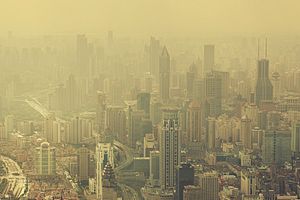At the 2015 United Nations Climate Change Conference (COP21), participating countries recognized the need to limit anthropogenic greenhouse gas emissions, setting an aspirational long-term goal of limiting global warming to 1.5 degrees Celsius. As laudable an accomplishment as that is, the consequences for failing to limit air pollution in the short term is dire – the American Association for the Advancement of Science (AAAS) recently found that air pollution caused 1.6 million deaths in China and 1.4 million in India in 2013. In the very best case scenario in 2030, there will still be 990,000 to 1.3 million deaths a year in China attributable to air pollution.
China’s air quality situation is grim from beginning to end. Already the undisputed world leader in greenhouse gas emissions from coal, the Chinese government recently released data indicating that it has been burning 17 percent more coal per annum than previously disclosed. That translates into roughly a billion more tons of CO2 than previously thought, bumping the country’s total output up to 8.25 billion tons per year of the greenhouse gas. The 17 percent difference is about the same as 70 percent of the total coal used each year in the United States. Such a grievous inability to even publish correct numbers regarding the problem certainly calls into question the government’s commitment to fixing that problem.
In an effort to limit coal use, the Chinese Communist Party pledged to lower its steel output. China’s heavy industry is powered largely by coal, and the sector is the primary user of especially dirty high-sulfur varieties. Although the country has cut around 90 million tons of capacity in recent years, the central government has struggled mightily to meet targets set in the recently-ended 12th Five-Year Plan. China’s State Council has pledged to eliminate 100 million to 150 million tons of capacity, but, perhaps learning from recent history, has not set a date for this goal to be met.
China’s stated goals for reducing coal production seem laudable on their face, but a closer examination shows how miniscule those cuts actually are. The country recently announced that it would spend about $4.6 billion to close 4,300 small coalmines and redeploy up to one million workers employed at the mines. This should reduce production by 700 million metric tons over the coming three years. However, even after shutting 7,250 mines already, the country still has 11,000 mines, which, due to dropping demand, are significantly oversupplying the country’s coal market.
The air pollution crisis in China isn’t just harmful to human health. According to estimates, air pollution reduces China’s GDP by 6.5 percent per annum. The losses are largely attributable to lost productivity due to factory closures on bad air days. Chronic illnesses caused by pollution, including heart disease and lung cancer, are also drags on the country’s economy. Tourism and outdoor recreation are also negatively impacted by poor air quality.
The perpetrators of the problem aren’t exactly a mystery, either. A video released immediately prior to COP21 by the Sierra Club identified 21 Chinese people and their enterprises who are responsible for fully one-tenth of the planet’s carbon dioxide emissions, making 21 separate fortunes totaling $70 billion in the process. There is little question that China could do more to stop their pollution.
India faces an air pollution problem of its own, and of equally staggering proportions. However, while coal is the main culprit in China, India uses different fuels for polluting its atmosphere. “[I]nIndia, a very significant number of the people still burn very poor wood and biomass fuels, cow dung, and other sources,” said the president of the non-profit Health Effects Institute in Boston, Dan Greenbaum. “And that creates major exposures indoors to the mothers and children, for example, who are cooking or are near the stove,” he explained.
According to the experts, the country has a war to fight on three main fronts. “India needs a three-pronged mitigation approach to address industrial coal burning, open burning for agriculture, and household air pollution sources,” said Chandra Venkataraman, professor of Chemical Engineering at the Indian Institute of Technology Bombay, in Mumbai, India.
India has taken some steps in the right direction in fighting this battle, but the improvements have been marginal at best. The country implemented alternating odd/even license plate driving restrictions earlier this year. According to the government, particulate matter trended downward as a result. On the other hand, an independent watchdog group measured for the same pollution and showed levels had increased from the month prior to the restrictions’ implementation.
Even if India has a burgeoning green energy sector, much more must be done in the short term to get it up to speed with the country’s energy needs and their dependence on coal. India has the world’s fifth largest coal reserves, and the government is preparing to unleash the private sector on it. Private companies, previously only allowed to use the coal they mined in their own industrial applications, will soon be permitted to sell coal on the open market. The country’s use of coal for power generation is booming – statistics showed a 15.4 percent increase in coal-fired power generation from the period of April 2013 and October 2013 to the corresponding period in 2014.
China and India have their work cut out for them. It isn’t too late to limit the damage already done if they have the political and economic will to make the needed sea change. But change must come soon. The lives of tens of millions of people depend on it – the very air they breathe is killing them one breath at a time.
Anthony Kleven is an economic risk consultant based in Singapore. The views expressed here are his own.

































